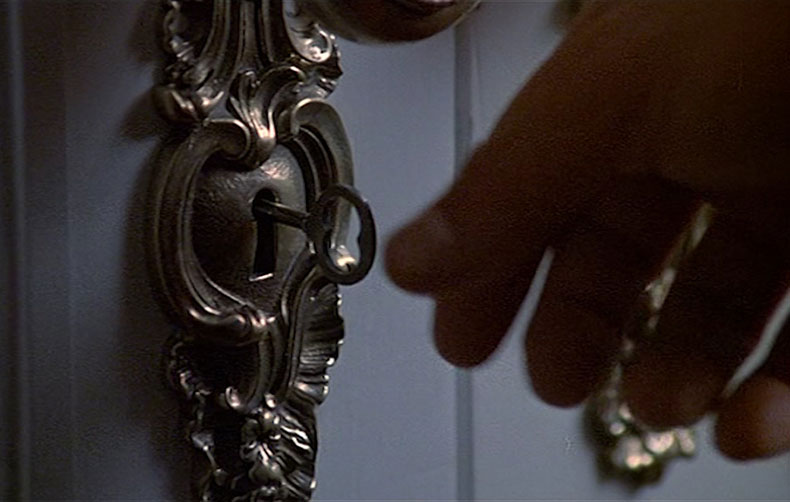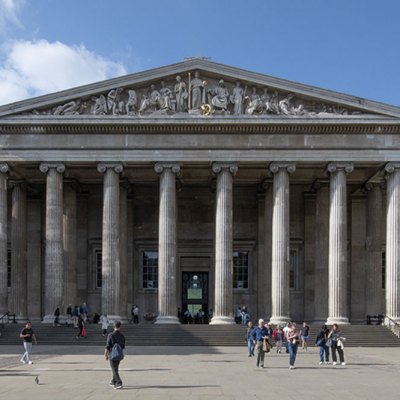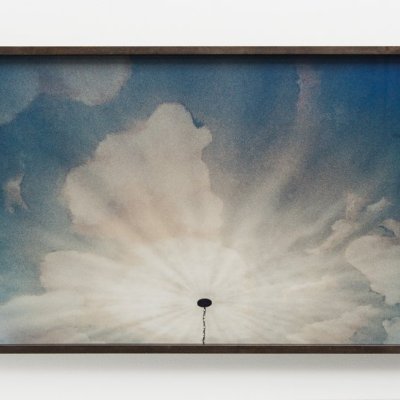As with much of Christian Marclay’s work, the idea behind Doors is simple. The piece consists of film clips in which characters pass through doors. That is it. From one door to another, one clip to another, one character to another, spilling fragments of dialogue as they go, ad infinitum on a recurring loop of undisclosed duration. On they dash, as the film does, going with apparent purpose absolutely nowhere. The final impression is of great speed without direction, movement that passes from one space to another without ever achieving progress. As a viewing experience it is stymieing, claustrophobic, and almost suffocatingly repetitive. At the same time, it is almost impossible to look away from.
It should go without saying, after the global success of The Clock, that Marclay is very, very good at editing. Or rather, he is a genius at taking advantage of the mind’s desire for continuity. We are sense-making machines that will, if at all possible, construe the juxtaposed as contiguous, the fragmentary as the whole, a set of disconnected dots as a story. Marclay has played on this instinct across his whole career, from early sonic adventures in sampling and musique concrète, through visual works such as Recycled Records (1980–86) and Body Mix (1991–92), up to the career-defining peaks of Video Quartet (2002) and The Clock (2010). Whatever the medium of any given piece, he is above all else a collagist.
A still from Doors (2022) by Christian Marclay. Courtesy White Cube; © the artist

That technique is writ large in the sculptures that act as a kind of amuse bouche for Doors. Here, salvaged doors are subjected to various processes of de- and reconstruction as if to see just how far they can be taken from their original forms and still retain an essential doorness. One is hollowed to a spindly wisp of itself (Skeleton Door, 2023), another becomes a kitschy inverted cross (Crosscut (Yellow Door), 2023), others reappear as short stacks and tall, topped with handles, flanked by empty hinges. A little like the old kid’s joke, a door is always a door, even when it’s ajar.
In the film, the stacking is serial and recursive. Edits come thick and fast as Marclay’s cast of filched characters enter and exit, each clip a few seconds long at most. There are repetitions within the overall loop – Sidney Poitier exiting a classroom furiously from To Sir, with Love, Mia Farrow paranoically exploring her closet in Rosemary’s Baby – but no sense of comforting landmarks or final returns. Instead, the mind scrabbles to extend the action of one clip into the next, into the next, into the next. A door flung open in 1970s technicolour becomes the same door that bangs against the wall a second later in 1950s black and white; Poitier strides into his staffroom and is transformed into another actor the instant he does so. The fact that any given linkage breaks down almost as soon as it is formed is the point: Marclay provides just enough continuity to keep the involuntary mental reflex at work without ever allowing it to give up. There are at least two instances of invisible men, whose moving lacunae come almost as a relief in the constant flurry of it all.
A still from Doors (2022) by Christian Marclay. Courtesy White Cube; © the artist

Despite the fact that Marclay is keen to avoid talking of Doors as a follow up to The Clock, the comparison is instructive. They share the same techniques, and to some extent the same lapidary brilliance of construction; and they share too the sense of acting as a lesson in the language of cinema. While The Clock revealed the underlying grammar of cinematic time – the different personalities of its hours, the different significances of its flow and intonation – Doors is a lecture on the cinematic door. It is in part a taxonomy of doors themselves – cell doors, domestic doors, lift doors, classroom doors… locked doors, lit doors, dark doors, numbered and unnumbered doors – and in part a thesis on their aspects and behaviours. A door in earshot of running water is a door for sneaking through; a door in a darkened room is a door for hiding behind; a door near a desk is always closed but never locked. Doors, in general, come not singly but in pairs and flocks, and their preferred habitat is the corridor. You learn, too, that handsome men use doors differently to ugly men, and differently again to beautiful women, who as often as not have something to fear from the other side of their doors.
As a lecture, it is fascinating, and – like The Clock – oddly gripping. Unlike The Clock, though, it is above all else discomforting. While The Clock offered the sense, for all that happens in its event-filled duration, that everything will return once more to its starting point and begin its journey again, Doors offers only a ratcheting sense of locked-in reduplication. The only kind of door that Marclay refuses the viewer is an exit. There are no exterior shots, no deep breaths of escape, only the piling sense of a cast trapped in a continuously extending labyrinth. It is to film what Piranesi’s Carceri is to prisons: a creation in which the overwhelming urge to escape is matched only by the urge to stay and explore.
‘Doors’ is at White Cube, Mason’s Yard, London until 30 September.



